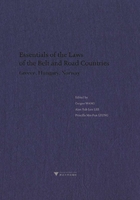
Preface
The Belt and Road(“B&R”)Initiative, since it was officially announced by the Chinese Government in 2013, has generated much excitement not only within China but also internationally. The“Belt”refers to a transnational economic cooperation initiative among the countries along the ancient Silk Road from central China to central Asia and then to Western Europe with Amsterdam as the finishing point—the“Silk Road Economic Belt”; the“Road”indicates an economic cooperation initiative among countries along a new maritime Silk Road from China, South-east Asia, India, Sri Lanka, Yemen, Egypt, Greece, Italy to the Netherlands(Amsterdam)—the“Maritime Silk Road”. As such, the B&R Initiative mainly focuses on the connectivity and cooperation among countries in Eurasia and some African countries. The National Development and Reform Commission, Ministry of Foreign Affairs and Ministry of Commerce of China with the authorisation of the State Council of China released the official document“Vision and Actions on Jointly Building Silk Road Economic Belt and 21St-Century Maritime Silk Road”in March 2015, which outlines the direction and rough contents of the B&R Initiative. An official B&R Initiative website was launched in March 2017. Yet, none of these official documentations indicates what specific countries are covered under the B&R Initiative, which implies that the B&R Initiative is an open-ended concept. Having said that, it is clear that the B&R Initiative aims at promoting economic cooperation among the countries concerned. It is equally clear that with or without a precise coverage, the B&R Initiative includes a large number of countries with different cultures, history, traditions, religions, and political and legal systems.
By its nature, implementation of the B&R Initiative involves cross-border movement of people, goods and services, capital and technology, a process which unavoidably entails interactions among the concerned countries. What norms should be observed in transacting business in these countries? Do as the Romans do, according to Western culture. As for the traditional Chinese culture such as the Book of Rites(Liji Quli I), “When crossing the boundaries(of a state), one should ask what its prohibitory norms are; having fairly entered it, one should ask about its customs; before entering a house, one should ask about the names to be avoided whilst in it. ”Knowing the prohibitory norms, customs and names to be avoided of each country along the B&R is of utmost importance for the successful implementation of the initiative. It is precisely for this reason that this book series—Essentials of the Laws of the Belt and Road Countries—has been prepared.
This book series had its origin in a workshop that was held by the International Academy of the Belt and Road in Hong Kong, where some of its authors were present. The consensus of the workshop was that mutual understanding among the B&R countries over their legal traditions, constitutional and governance frameworks, laws on trade transactions and other immediately relevant areas such as financial regulation, employment law and environmental law was crucially important for implementing the B&R Initiative. It is only through a proper understanding of commonalities and differences between these nations that we could develop a meaningful framework for carrying out the related trade, investment and other activities.
The authors were provided with terms of reference for the chapter construction. Each country study would begin with an overview of its legal system relating to cross-border commercial transactions. The substantive parts of each chapter deal with customs systems, foreign trade law, law on foreign direct investments, monetary and banking law, laws relating to construction and infrastructure, labour management and treatment, environment and dispute resolution—both judicial and non-judicial(ADR).
It is also part of the terms of reference that the authors should focus not only on the black letters of the laws but also on how these laws in fact operate in the market place. The authors were given a fair amount of leeway in examining each of these aspects in order that they could highlight those areas where their own nations would have a particular interest. The result is a happy blend of not only different writing styles but also different aspects of law in action.
A distinctive feature of this highly globalised world is coexistence of multilateral and bilateral economic cooperative schemes. As a result, trade and investment barriers have been removed or reduced with the development of both multilateral and bilateral cooperative programmes. These schemes not only regulate trade, investment and finance and banking at the international level but also directly impact on lawmaking and law enforcement at the national level. For this reason, we decided to have chapters devoted to two such associations—the European Union and ASEAN. These chapters provide support to the study of countries belonging to these associations and explain the interrelations that exist in terms of laws and legal processes between the central authorities and member states. A study of how EU and ASEAN authorities guide, coordinate and encourage a unified legal order for the promotion of trade and economic cooperation is also critical to the B&R Initiative which can learn from relative successes and lessons of the existing regional organisations.
When the B&R Initiative was first introduced, the United States and Japan were not among the B&R countries. Yet, as they are important countries for international economic cooperation, the B&R Initiative is an open concept and there are signs that the two countries may eventually take part in the B&R Initiative, we decided to include them in this book series.
We believe that, by providing an overview of the laws and legal structures that shape business relationships of the countries along the B&R, this book will contribute in a meaningful way to the implementation of the B&R Initiative.
Guiguo WANG
Alan Yuk-Lun LEE
Priscilla Mei-Fun LEUNG
18 April 2017